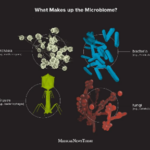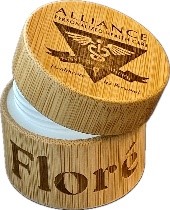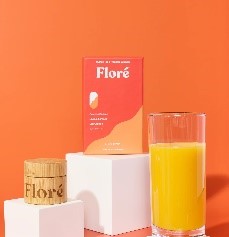I once heard a microbiologist say that the human is nothing more than a transport medium for the microbiological world. What he is inferring is that though we use our 30 trillion cells to orchestrate physical movement in this world, the 40 trillion microbes that live within us lack that mobility. That’s not a type-o … there are likely more microbes living within the gut than there are human cells for any individual. And it would be too anthropocentric of us to think we should ignore them. Though small in size, they do outnumber us, and what they lack in size they make up for in a complicated world of symbiotic relationships, outright battle for dominance, and production of by-products to improve their own environment which directly affects our gut health and overall sense of well being.
Let’s talk about some common maladies for which we should consider the microbiome. There are many who suffer from recurring or constant difficulties involving nausea, pain, change in bowel habits, and food intolerances. So often, an extensive workup finds no severe problem that needs intervention. After that good news, the focus turns to managing symptoms. And that’s where things remain difficult for years, involving medications with side effects and expense. Of course, it’s in vogue to talk about food allergies and to adjust our diet, but why does that matter when it’s not a true allergy? Remember those trillions of microbes? Could they be part of the problem or part of the solution? Turns out, the answer is yes. Not always, but a lot of the time. For what we call functional abdominal pain (anatomically fine, no obvious disease, just doesn’t function smoothly), it can often be from “dysbiosis”, an imbalance in the groups of microbes. We humans function smoother when the various groups of organisms remain in a steady state. When one group outmaneuvers another or migrates location within the gut, it can create dysbiosis and functional abdominal pain. That’s where probiotics get their credibility. But which probiotic (hundreds to choose from) and in which combination? The reason there is so much confusion is that each of us is unique. Imagine that; one size does not fit all.

It’s easy to understand how the microbiome may influence food allergies, irritable bowel syndrome, and inflammatory bowel disease. But, believe it or not, the microbiome is now being looked at as being one of the overarching areas that can be manipulated to improve conditions as diverse as autism, chronic fatigue syndrome, immunodeficiency, autoinflammation, and certain cancers. How much it can help is definitely unclear. Most have heard about the benefits of taking a probiotic following oral antibiotics. It certainly CAN help, as long as the proper probiotic is used and as long as it makes it past the acidic environment of the stomach. In choosing that probiotic, it’s tough to decide which one is the best, the one with the red label, the blue label, the green, the orange, the live cultures, the spores, the one with prebiotic AND probiotic. It’s almost impossible.

And unless you have a degree in microbiology, you may be unaware that those 40 trillion organisms are a mixture of bacteria (aerobic, microaerobic, anaerobic), viruses (both those that affect humans and those that affect the bacteria), fungi (in both yeast and spore forms), protozoa, helminths (worms (yuck)), and archaebacteria (the ancients). Many maladies in medicine have treatments and some have cures, but sometimes all we can do is alleviate symptoms. The microbiota can be part of all of these. Sometimes there is ONE microbe that is the offender. We try to eliminate it with an oral medication. However, it is very unlikely that the medicine acts like a “magic bullet or a smart bomb”. The treatment is far more likely to act like a “nuclear bomb” and kill both its target and a whole lot of innocents. Smarter would be to recruit some microbes to engage in battle with their neighbors or to foster an increase in certain microbes numbers so as to produce metabolites that will benefit us. We just don’t know how to do that yet.

What we can do is analyze the stool and generate a complex report that shows what percent of each known microbe is present, similar to this. After testing tens of thousands of patients, we pretty much know what is normal. Often, in an ill patient, there will be an overgrowth of a microbial family that coincides with known symptoms. Let’s say there is a lower concentration than normal of “Bacteria A (an aerobe)” and there is a higher than normal concentration of “Bacteria B (an anaerobe)”. Let’s also say that the profile is from a patient suffering from a lot of bloating and secondary pain. Let’s also say that Bacteria A is known to compete for the same living space as Bacteria B. Seems like Bacteria B is overpopulated. It may be known that Bacteria B is a gas producer. Suddenly things make more sense. The natural tendency is to want a medication to eliminate Bacteria B. Wrong call though (nuclear bomb scenario). A better answer would be to deliver substrate (food) that is preferred by Bacteria A and let it grow in numbers. That’s what I mean by recruiting certain bacteria to benefit us. Often, that can alleviate the patient’s symptoms.

However, a random supplement off the shelf is not likely to be the solution. Trial by error is fine and sometimes it works well. My family found one specific probiotic that helped some of them. But the others it didn’t. I’m sure many of you have similar stories. This is one of the new frontiers in medicine: knowing what lives within us, and working with them to help improve our lives. A lot of that will be diet (we are what we eat). A lot of that can be the right supplements. As a microbiologist before becoming a doctor, I couldn’t be more excited to finally see this frontier opening up with a lot of research. In the news, we have seen fecal transplants, phage therapy (viruses that kill bacteria), prebiotic therapies, low inflammatory diets, amino acid therapies, and of course probiotics.

At Alliance, we are pleased to have a relationship with a company that has brought some objective science to what has been a subjective field. If you have chronic abdominal complaints, this may be something worth pursuing. It is a test and product outside of traditional insurance coverage, but is reasonable in cost, or we wouldn’t offer it. The company is Flore.

They have several products, but we recommend one called “GI SereniT”, available via a prescription from us. On a six month trial, they will have you send in a stool sample (I know, gross, but how else?) via a very simple auto disposing sanitary towel collection method. They analyze the stool to generate a profile of YOUR microbiome. A naturopath health care provider then reviews the health survey that you returned with the sample.

A matching pattern of microbial overgrowth/undergrowth and patient symptoms is searched for.

Then, a custom blend of probiotics is made to adjust that pattern. I specifically asked them how many formulations they have. The response was that they have zero on the shelf, but thousands of possibilities based on the recipe recommended by the doctor. It is truly custom. They then package a huge number of live probiotics (higher than just about anything over the counter) and most of it is not spores, so it will be shipped cold and kept in the refrigerator. One capsule daily, inside a personalized container (nice personal touch).

But like the infomercials have said for years, “but wait, there’s more!”, they also provide the PREbiotic for the PRObiotic. That is the food for the probiotic to flourish and populate (think of a new plant outdoors au natural or with some fertilizer). After three months, they want another sample and another medical report. That will assess whether the blend actually accomplished the goal of both normalizing the microbial pattern and relieving the patient’s symptoms. If that didn’t work, they reblend and try again. If that did work, then it settles into a daily probiotic that shows up at the house.

And how does it just show up? YOU talked with US. There it is again, merging YOUR story with OUR experience, while engaging MODERN TECHNOLOGY. When we say things are different at our practice, we mean it.

Confused? No problem. It’s extremely complicated. Come on in. Take a seat. Have a drink from the cooler. We can explain it all.

